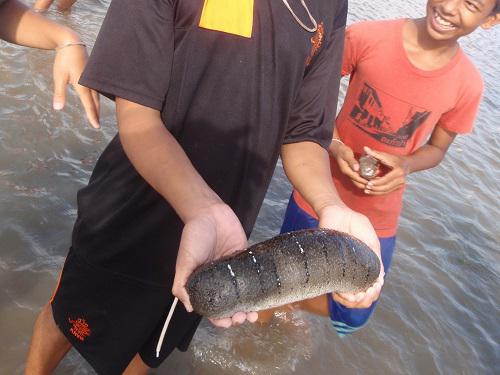Barry Bendell
Other projects
18 Oct 2016
An Alternative Approach for the Conservation and Farming of the Endangered Sea Cucumber Holothuria scabra
Marine Protected Areas (MPAs) have been established under community-based management in 2 seagrass meadows on Phra Thong Island. Their effectiveness will be evaluated by comparing changes between protected and non-protect areas in the abundances and sizes of harvestable invertebrate animals and seagrass cover.

A large sea cucumber, Holothuria scabra, from the protected area at Tha Pa Yoi.
Phra Thong is a large island on the Andaman coast of Thailand that has extensive seagrass meadows on its eastern side. At low tide, people of all ages collect molluscs from the meadows, especially Strombus canarium (dog conch), along with other valuable animals such as the sea cucumber Holothuria scabra (sandfish). There has been intense, unrestricted harvesting near villages, which has led to fears of over-exploitation. The villages of Tha Payoi and Pak Chok (Lions) have established marine protected areas (MPAs) in their seagrass meadows. They wish to demonstrate that they can manage their own resources wisely, and this project supports their initiative and plans to provide a quantitative evaluation of the effectiveness of their MPAs.
Populations of edible molluscs and sea cucumbers have been declining around the island, and it is hoped that the MPAs will increase their abundances, and provide nursery habitat and shelter for a diversity of animals. The MPAs each cover an area of approximately 14 ha of intertidal seagrass from which all fishing activities are prohibited, except for the use of mullet nets at Tha Payoi. Changes in the populations and sizes of large invertebrates will be monitored and compared between plots inside and outside the MPAs by counting and measuring animals along 50 m belt transects. Preliminary sampling shows that populations of conch and sea cucumber are uniformly low, but that the sea star Archaster typicus, which has no commercial value, is extremely abundant at Pak Chok (Lions). Seagrass is the foundation of the community and an important indicator of environmental conditions, and so plots are also being monitored for changes in seagrass cover both within and without the MPAs.
The villages of Tha Payoi and Pak Chok (Lions) want to conserve and manage resources for their future use. Protected areas have become common tools for managing coastal resources, but there are few evaluations of their effectiveness, especially of small-scale areas in seagrass meadows. By monitoring the seagrass and its animals, protected areas can be assessed and the data used to inform and support community-based initiatives in those villages and others in the region.